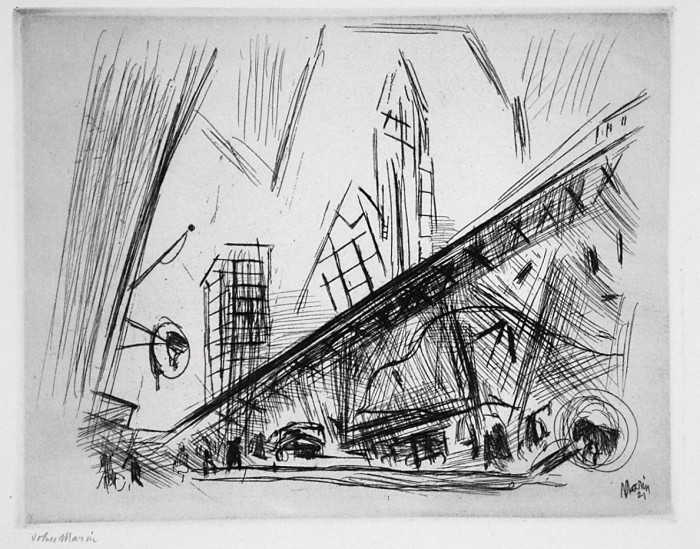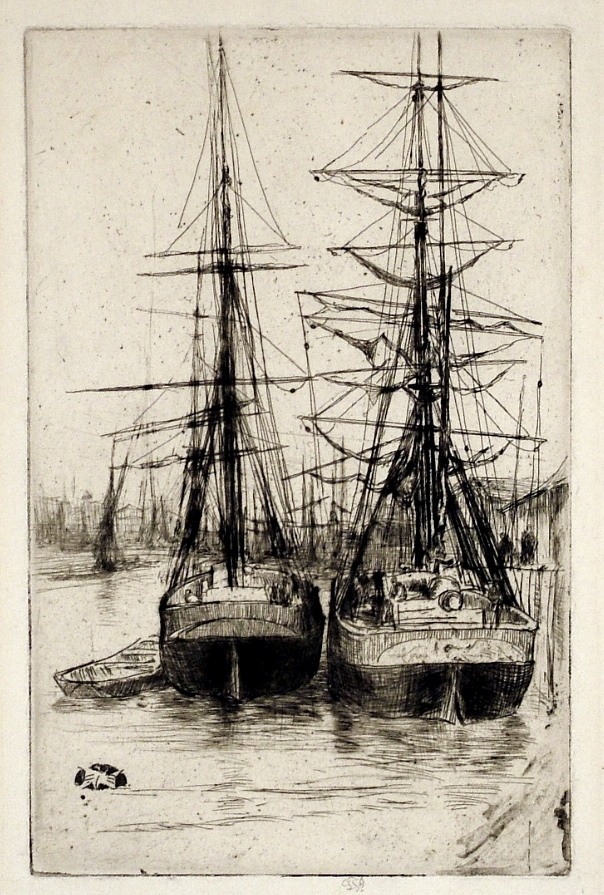
Six American Etchings: The New Republic Portfolio 1924
The complete set of six etchings, as issued in 1924, including:
Peggy Bacon (1895-1987), The Promenade Deck, 1920 (Flint 47), 6 x 8 3/8 inches
Ernest Haskell (1876-1925), The Sentinels of North Creek, ca. 1923, 5 x 7 7/8 inches
Edward Hopper (1882-1967), Night Shadows, 1921 (Levin 82) 7 x 8 3/8 inches
John Marin (1870-1953), Downtown the El (Zigrosser 134), 6 7/8 x 8 3/4 inches
Hayes Miller (1876-1952), Play, 1919, 4 7/8 x 5 7/8 inches
John Sloan (1871-1951), Bandits Cave, 1920 (Morse 195), 7 x 5 inches
A fine set; each impression in excellent condition with full margins; the cover showing wear.
This set has unusual historical importance: it includes prints exemplifying both traditional approaches to American printmaking, including those by Haskell, Miller, Bacon, and Sloan, as well as examples of important early American Modernist printmaking: Hopper’s Night Shadows and Marin’s Downtown the El.
In 1924 The New Republic offered readers a set of six original signed etchings along with the purchase of a subscription to the magazine. The original offering, in an advertisement in the Saturday Review of Literature (December 6, 1924, p. 350), reads in part:
SIX ETCHINGS
Incomparable as Christmas Gifts
Originals – Not Reproductions: Each Proof Printed by Peter J. Platt, on Handmade Van Gelder Paper Signed by the Artist, and Offered At Incredibly Small Cost with a Subscription to The New Republic The Ablest of America Weeklies. The difficulty with this offer is not to explain, but to refrain…Yet orefrain…Yet overstatement is almost difficult in face of the facts—the foremost of which (alone simply sufficient to testify to the quality of these etchings) is the names of the six artists themselves.” A subscription form was then appended, offering readers a year’s subscription to the New Republic, with the set, for $8 (or two years for $12; the New Republic alone was $5 a year).
The edition size is not known. In a letter to John Sloan dated January 14, 1925, Robert Hallowell, secretary of the New Republic, writes, referring to set,“These went very well up until the end of last year. Since then, however, the orders have dropped off so considerably that I think there is considerable doubt that we will ever dispose of as many as a thousand sets. Up to date the total is between five and six hundred.” (Morse, 1969, p. 221).
Each of the artists represented in the portfolio was important. At the time of the publication of the set, John Sloan was one of the best-known artists in America, a member of the Ashcan School, a painter represented in great museums throughout the country, and a major printmaker as well. Hayes Miller was known not only as an artist but also as a teacher whose students included the artists of New York’s Fourteenth Street School, including Peggy Bacon, an early Modernist who became a leading book illustrator (and was the youngest artist to produce a piece for this set). Ernest Haskell was already prominent in the United States and in Paris, noted as an etcher and student of Whistler. By 1924 Edward Hopper was beginning to earn recognition as one of America’s great young artistic talents; and John Marin had already been widely recognized for his role in creating some of the first American Modernist paintings and prints after the Armory Show in 1913.
This set represents an important landmark in American printmaking.
Note: this set is currently not for sale; inquiries are welcome.

Marin – Downtown the El
Posted in Edward Hopper, Ernest Haskell, John Marin, John Sloan, Kenneth Hayes Miller, Peggy Bacon |






